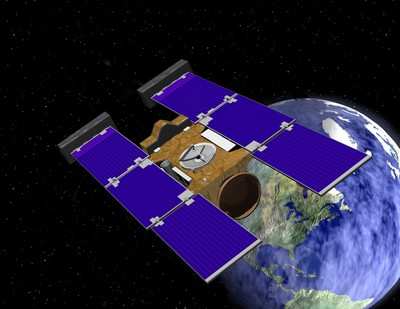Wed, Jan 14, 2009
Intrepid Spacecraft Enroute To Rendezvous With Comet Tempel
1
On January 14, NASA's Stardust-NExT spacecraft will fly by Earth
during a gravity assist maneuver that will increase its velocity
and sling shot the spacecraft into an orbit to meet up with comet
Tempel 1 in February 2011.

Flight operations for the spacecraft are performed from Lockheed
Martin's Mission Support Area in Denver, CO. The Jet Propulsion
Laboratory in Pasadena, CA provides the precision navigation need
for the flyby and the journey to Tempel 1.
The Lockheed Martin-built spacecraft's closest approach will
happen at 12:33 p.m. MST as it comes within 5,690 miles of
Earth. At its closest point, the spacecraft will fly over the
California/Mexico border south of San Diego at a speed of
approximately 22,400 miles per hour (36,000 kilometer per
hour).
"We performed our final trajectory correction maneuver on
January 5 that put us into a precise position for the flyby," said
Allan Cheuvront, Stardust-NExT program manager at Lockheed Martin
Space Systems Company. "On January 10, we sent the last set of
commands to the spacecraft that it will use to perform the gravity
assist maneuver. We're in great shape and we're looking forward to
seeing Stardust fly by before it heads back into deep space."
This isn't the first time Stardust has flown by Earth. The first
was January 15, 2001 when it used the Earth for a gravity assist to
meet up with comet Wild 2. Five years later on January 15, 2006,
the spacecraft flew by Earth
as it released its sample return capsule safely back to
Earth, which held particles from comet Wild 2 and
interstellar dust.
The Stardust-NExT (New Exploration of Tempel) mission is a
low-cost mission that will expand the investigation of comet Tempel
1 initiated by NASA's Deep Impact spacecraft. The mission uses the
still-healthy Stardust spacecraft to perform a flyby of comet
Tempel 1 and obtain high-resolution images of the coma and nucleus,
as well as measurements of the composition, size distribution, and
flux of dust emitted into the coma. Stardust-NExT will also provide
important new information on how Jupiter family comets evolve and
how they formed 4.6 billion years ago.
More News
Also: B-29 Superfortress Reunion, FAA Wants Controllers, Spirit Airlines Pulls Back, Gogo Galileo Van's Aircraft posted a short video recapping the goings-on around their reorganiz>[...]
Light Gun A handheld directional light signaling device which emits a brilliant narrow beam of white, green, or red light as selected by the tower controller. The color and type of>[...]
"The journey to this achievement started nearly a decade ago when a freshly commissioned Gentry, driven by a fascination with new technologies and a desire to contribute significan>[...]
"Our driven and innovative team of military and civilian Airmen delivers combat power daily, ensuring our nation is ready today and tomorrow." Source: General Duke Richardson, AFMC>[...]
Aircraft Conflict Predicted conflict, within EDST of two aircraft, or between aircraft and airspace. A Red alert is used for conflicts when the predicted minimum separation is 5 na>[...]
 Airborne 04.16.24: RV Update, Affordable Flying Expo, Diamond Lil
Airborne 04.16.24: RV Update, Affordable Flying Expo, Diamond Lil ANN's Daily Aero-Term (04.20.24): Light Gun
ANN's Daily Aero-Term (04.20.24): Light Gun Aero-News: Quote of the Day (04.20.24)
Aero-News: Quote of the Day (04.20.24) Aero-News: Quote of the Day (04.21.24)
Aero-News: Quote of the Day (04.21.24) ANN's Daily Aero-Term (04.21.24): Aircraft Conflict
ANN's Daily Aero-Term (04.21.24): Aircraft Conflict



